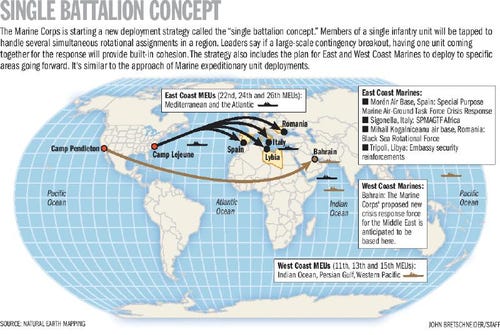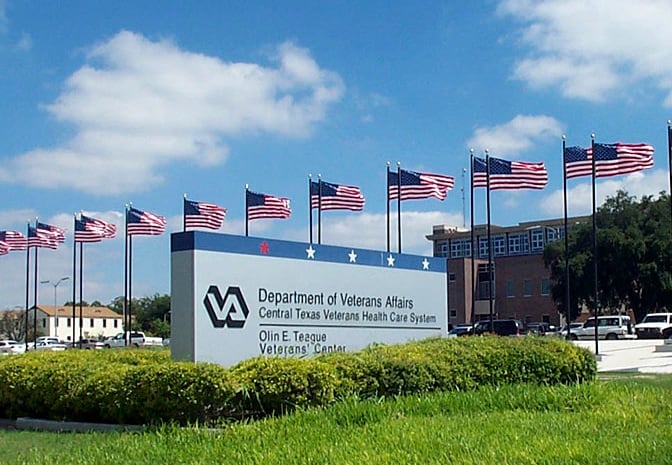source GAIA package: Sx_MilitaryTimes_M6201410301270015_5675.zip Origin key: Sx_MilitaryTimes_M6201410301270015 imported at Fri Jan 8 18:18:13 2016
 The Marine Corps' post-Afghanistan deployment plans are taking shape, and personnel can expect today's vigorous operational tempo will continue as leaders reorient the service and rebrand it as a nimble crisis-response force.
The Marine Corps' post-Afghanistan deployment plans are taking shape, and personnel can expect today's vigorous operational tempo will continue as leaders reorient the service and rebrand it as a nimble crisis-response force.
As infantry companies are called on to back up embassy security guards in Africa and the Middle East, and more adviser teams push into Central America, Africa and the Middle East, the Corps' new approach calls for East Coast and West Coast units to adopt deployment patterns like those inherent to Marine expeditionary units. As such, West Coast Marines will likely find themselves handling missions in the Middle East while those based on the East Coast are sent to Europe or Africa. Of course, plans are contingent on world events and the needs of the Corps.
It has been named the "single battalion concept" and calls for assigning members of one unit to multiple missions spread out across a large geographic region. The first glimpse of this can be seen now across Europe and Africa, where members of 3rd Battalion, 8th Marines, out of Camp Lejeune, N.C., are operating within two combatant commands — U.S. Africa Command and U.S. European Command — and carrying out three distinct rotational missions in addition to providing embassy security.
Capt. Eric Flanagan, a Marine spokesman at the Pentagon, said the single battalion concept provides combatant commanders with one cohesive entity, not a hodgepodge of personnel from three or four units who might not have experience working together. Heretofore, these rotational deployments to Africa and Europe were being carried out by a mix of active-duty and Reserve units from all over.
Deployment changes will extend beyond the infantry community, though, and encompass manning for the Corps' current and future crisis-response air-ground forces, security cooperation adviser teams and the Unit Deployment Program for the Asia-Pacific region, where the volume of rotational Marines is expected to swell. And as many Marines have learned firsthand, those assigned to the six U.S.-based MEUs will experience longer pumps, on average, compared to only a few years ago as fewer Navy ships are available.
There were hopes of providing Marines with more time at home — what's known as dwell time — once the Corps leaves Afghanistan this year. But the push to cut active-duty end strength to 174,000 likely will render that goal unattainable, leaders have said.
In mapping future force structure, Marine officials aimed to establish a postwar dwell-to-deployment ratio of three to one, meaning troops would spend three months at home for every one month deployed. Instead, the current two-to-one ratio, to which Marines and their families grew accustomed shortly after 9/11, is expected to remain the norm. So most Marines will be deployed six months out of every 18.
Special Purpose MAGTFs
East Coast Marines will continue to staff the Corps' new Special Purpose Marine Air-Ground Task Force Crisis Response, Flanagan said. Based at Morón Air Base in Spain, it focuses on flashpoints throughout Africa and comprises about 550 Marines, coming from the combat arms, aviation and support communities. In January, U.S. officials asked the Spanish government for permission to boost the unit's footprint by about half, meaning it could expand to about 825 personnel, the Spanish newspaper El Pais reported.
As part of the single battalion concept, members of 8th Marines form the task force's headquarters element with ground and logistics combat elements coming from 3/8.
Most, if not all, of the remaining Marines with 3/8, will comprise two rotational units that aim to enhance military partnerships in Eastern Europe and across Africa: Black Sea Rotational Force, based at Mihail Kogalniceanu Air Base in Romania, and SPMAGTF Africa, based at Naval Air Station Sigonella, Italy. An unspecified number also will provide security reinforcement at the U.S. embassy in Tripoli, Libya.
Members of 3/8 took over SPMAGTF Africa on Jan. 8. BSRF, currently manned by 2nd Light Armored Reconnaissance Battalion out of Camp Lejeune, will swap out with members of 3/8 in March. Each deployment is expected to last six months.
To prepare for such a novel deployment, 3/8 and the regiment's headquarters element conducted predeployment training while spread across four military bases and two states. They were positioned between Marine Corps Base Quantico, Fort A.P. Hill and Fort Pickett in Virginia, and Marine Corps Auxiliary Landing Field Bogue, N.C. The distance was meant to simulate being spread across two continents overseas.
West Coast Marines expected to apply the single battalion concept will likely head up deployments to the Middle East, according to a Marine official familiar with the plan. He spoke on the condition of anonymity because the plan is still in the early stages.
A crisis response force for the Middle East, similar to the one based in Spain, has been in development for months. Officials have indicated that the new unit will likely be headquartered in Bahrain and answer to U.S. Central Command.
The Corps stood up a command element in Bahrain in 2011, which is built around about 150 headquarters staff personnel and is led by Brig. Gen. Gregg Olson. The headquarters provides the Corps with a permanent command element in the Middle East should military action there be needed.
It's not immediately clear how large CENTCOM's crisis response force will be and how Marines may be dispersed across the region once it activates. The command has oversight of U.S. military operations in the Middle East.
Also unclear is what kind of advising role Marines will play in the region post-Afghanistan. U.S. officials are currently in talks with leaders in Iraq, where security is deteriorating, but it appears small numbers of special operations forces — not conventional infantry troops — could be sent to Jordan to train Iraqi troops as they continue to deal with threats from al-Qaida.
There are plans to establish a similar task force that will answer to U.S. Southern Command, which oversees activity throughout South America, Central America and the Caribbean. That force is expected to be based stateside, at least to start. It's not immediately clear where that might be, but Marine Corps Forces South is headquartered in Miami.
Grunts guarding embassies
Like the Marines providing embassy security in Tripoli, other grunts will find themselves doing that mission as the U.S. seeks to shore up diplomatic posts in volatile regions. In September, about 100 Marines and sailors with Bravo Company, 1st Battalion, 1st Marines, out of Camp Pendleton, deployed to reinforce an unidentified embassy in CENTCOM, and members of 1/1's Delta Company went through related training the following month for an upcoming embassy-security mission in the Middle East.
Officials have divulged few details about these diplomatically sensitive missions. But with Lejeune Marines providing embassy security in Libya and Pendleton Marines guarding posts in the Middle East, the plan for sourcing them would appear to mirror the East Coast/West Coast setup being used elsewhere.
At the same time, the Corps continues to expand its stable of Marine security guards and has stood up the Security Augmentation Unit, a portion of which recently deployed to South Sudan to beef up security at the U.S. embassy in Juba while the Morón-based crisis response force assisted with civilian evacuations. But nevertheless, Flanagan said infantry units will continue to be tapped for these missions moving forward.
MEU pumps
Marines who've completed a MEU pump of late don't need to be told the deployments are getting longer. Fewer ships sailing means there's more to respond to. The North Carolina-based 26th MEU and California-based 15th MEU each saw eight-month deployments in 2013, up from the once-routine six-month pump. In 2012, the 24th MEU returned to North Carolina after nearly nine months away.
Where Marines go during these deployments is determined by their home base. When members of the 11th, 13th and 15th MEUs set sail from the California coast, they're typically headed towards the Indian Ocean and Persian Gulf, with training stops in places like the Philippines, Kuwait and Bahrain. Those who leave North Carolina with the 22nd, 24th or 26th MEUs head toward the Mediterranean and can expect to train in places like Morocco, Greece or Spain before heading on to the 5th Fleet area of operations, which includes the Persian Gulf, Arabian Sea, Gulf of Aden and other areas.
The advent of land-based crisis-response forces raises questions as to whether the MEUs will begin covering different areas of the world. That is to be determined, Flanagan said, noting that, for now, Marines can expect the standard schedule.
"MEUs will maintain their deployment tempo as we have — two currently deployed and one is predeployed," he added.
Security cooperation teams
In December, 20 Marines graduated from the Marine Corps Security Cooperation Group's schoolhouse in Virginia. The team comprised Marines from 17 units from all over the Marine Corps, with a variety of military occupational specialties, said Maj. Andrew Dirkes, the officer-in-charge.
The group recently deployed to Central America, where they then split into three smaller teams that are placed in Guatemala, Honduras and Belize. They are just one example of the dozens of security cooperation groups that leave the schoolhouse each year, armed with advising and mentoring skills, for missions all over the world.
Brig. Gen. David Coffman, commander of Marine Corps Forces South, said such small missions, with specific purposes, will become more common in the future. "I think as they come out of Afghanistan, Marines are wondering what they're going to be doing, what's next?" Coffman said. "I think this is what's next."
The Marines who deployed to Central America will work side by side with the local militaries as they help them develop skills to combat drug trafficking. Other security cooperation teams have advised troops in Afghanistan or trained members of the Presidential Guard in the United Arab Emirates. MEU commanders also send teams to the schoolhouse or request an instructor to teach a group of their Marines to work with local militaries they'll encounter during their deployment.
Coffman called the team a "low-cost, low-footprint solution" that can have a big impact. The small teams develop relationships with military personnel from all over the world, so if a large-scale contingency breaks out in that region, there's an existing relationship.
Even as the Marine Corps' focus became the wars in Iraq and Afghanistan, Flanagan said the service continued to deploy security cooperation teams to work with allies around the world. Any additional engagements will be conducted at the request of host nations' militaries and governments, he added.
Coffman says the demand from countries that want to work with the Marine Corps is greater than the service can meet. Security cooperation teams will remain a way for the Corps to meet these requests and to leave Marines with strong cultural expertise, small-unit leadership skills and good mentoring know-how, he said.
Asia-Pacific
Marines can still expect to participate in UDP deployments to Japan regardless of where they're based. As the Corps renews its shift toward the Asia-Pacific region, it will call on Marines from all locations — and nearly all communities — to complete rotational deployments through Okinawa, Australia and eventually Guam. Last summer, U.S. and Philippine officials met to discuss strengthening an already tight partnership, which could result in short-term Marine training rotations.
The single battalion concept won't affect unit deployments to this region. Because there will be so many Marines there, any unit from across the force — including those who've been tapped to handle deployments in a specific region like 3/8 is doing in Europe and Africa now — can find themselves tapped for a Pacific deployment, Flanagan said.
It's not immediately clear whether leaders could apply the single battalion concept to various missions or exercises in that region once personnel are there. Marines deployed to the Pacific already work closely together, and leaders say there is room for that to expand as more Marines deploy west of Hawaii. Lt. Gen. Terry Robling, the commander of Marine Corps Forces Pacific, identified at least 16 nations in the region that have expressed an interest in partnering with the Corps for disaster and humanitarian relief, crisis-response or other training, to include India, Vietnam and Russia.
Last fall, members of the Japan-based 31st MEU teamed with the Marine Rotational Force-Darwin, in Australia to perform a battalion-level training event. Col. John Merna, the commanding officer of the 31st MEU, said the opportunity for Marines deployed to the western Pacific to train together will only grow. More Marines in the area also means more opportunity to expand relationships with partner nations.
"As engagement opportunities increase because we have more unit deployment forces in the region, they'll be able to address more countries in the region, which we haven't been able to in the past because of deployments in the Middle East," Merna said.





